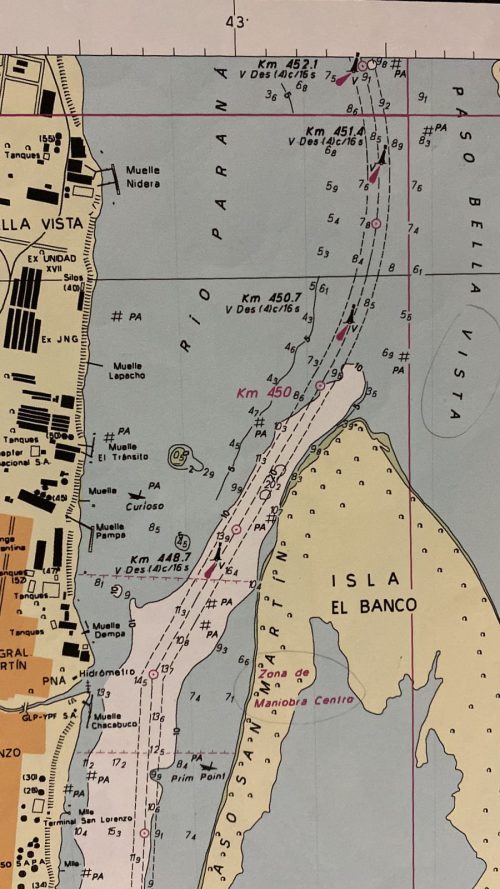


Project for a new route of the main navigation channel in the Paraná River
The Argentine National Department of Port and Waterway Control (Dirección Nacional de Control de Puertos y Vías Navegables) is processing a project for a change of route in the main navigation channel of the Paraná River in the Borghi/Bella Vista interpass, the complete Bella Vista passage, and a section of the Bella Vista/Abajo Correntoso interpass of the Paraná River. This work would be carried out between kilometers 447.8 and 453.4 of the Paraná River, enabling a navigation channel in the right arm of the river, while leaving the interpass sections and the current Bella Vista passage as secondary routes.
By implementing this project, in addition to rectifying the navigable route, the need for ships operating in the area to perform reverse maneuvers to exit the San Martín Canal would be avoided. Furthermore, it would achieve improved traffic flow for both upstream and downstream vessels by having two available navigation routes: the main one and the secondary one.
However, the rectification of the main navigation channel’s route would bring it closer to the operational dock area. This would require not only maintaining the prohibition on crossing/overtaking established in the current Ordinance No. 04/18 (DPSN) for vessels over 120 meters in length but also reducing the speed of ships when passing through different port facilities, resulting in an increase in transit time.
The projected new scenario, with ships passing at close distances and a possible increase in river current due to reduced flow in the future secondary route, would force the various terminals located in the area to internally reevaluate their respective mooring schemes as well as the structural resistance of docks, bollards, and mooring towers. If necessary, they would need to consider new vessel designs for each port facility.
Another consequence of the route change could be a decrease in the available anchoring, berthing, and maneuvering areas that serve the ports in the Timbúes – Puerto General San Martín – San Lorenzo port complex. These areas were established by the Maritime Authority and agreed upon with the various port terminals and pilots. Currently, there are anchoring zones for twenty vessels, six maneuvering zones, and two alighting zones. This availability has limited efficiency in serving the operations of at least twenty local port facilities.
Conclusion
The project for a change of route in the main channel of the Paraná River would provide benefits in terms of route rectification and a consequent reduction in course changes. However, it would present challenges due to the proximity to port terminals: vessel traffic would be affected as ships would need to reduce speed to avoid the effects of passing ships’ suction, and new areas for anchoring, maneuvering, and alighting would need to be allocated, along with adjustments to the mooring schemes of the port facilities.
The advantages or disadvantages of the project will depend on the execution of complementary works and new regulations that facilitate the distribution of vessel traffic and convoys without affecting the operations of ships docked in the port facilities of the area.
As the project progresses and its impacts on the efficiency of the waterway are further defined, they will be analysed and we will keep you posted on developments.
For additional information, contact us at info@itl-legalconsultants.com
The Team of IT&L Legal Consultants.